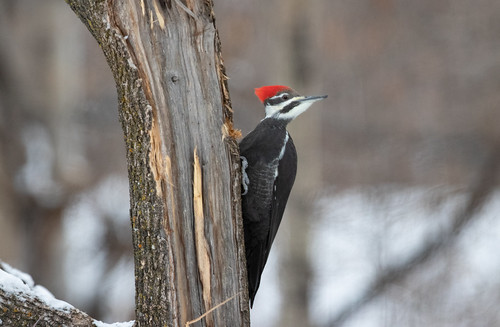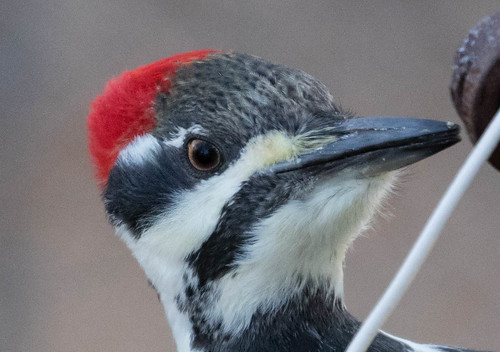Tuesday, December 4, 2018
The Value of One Individual
Last Wednesday, I witnessed a Sharp-shinned Hawk repeatedly attacking the female Pileated Woodpecker who hangs out in my neighborhood. The hawk attacked her over and over as the two of them worked their way west, finally out of sight and earshot, a case of “Exit, pursued by a Sharp-shinned Hawk.”
I didn’t see my female Pileated Woodpecker for the rest of the day. She usually doesn’t come around as often as her mate—he visits my trees and feeders at least three or four times most days, while I sometimes don’t see her for a few days running. Thursday I kept watch and she didn’t show up, but I tried not to worry.
Soon after the birds flew away on Wednesday, I posted about it on Facebook with one of the photos I’d taken of the attack. Most of the comments were sympathetic to both birds, but because I post so many photos of my two Pileateds, people were more worried about the woodpecker than the hungry hawk, just as I was.
Many comments were like this one, “ I hope she’s ok and that the sharpie has decided she’s too much work.” Only one person articulated a hope that the Pileated had pecked the Sharpie to death, and only a couple of people took a completely detached “nature red in tooth and claw” view. Somehow when you personally recognize one of the actors on either side of the predator-prey seesaw, this kind of story takes on a larger, more personal meaning, for better and for worse. Predation is natural and important, and it’s important not to trivialize it or to develop a hatred for hawks after this kind of encounter, but it’s hard to dismiss the fundamental value of a Pileated Woodpecker, too.
I wrote a blog post and produced a “For the Birds” program/podcast about the whole episode on Thursday, and linked to the blog on Facebook, getting even more comments.
That's when people started emailing and private messaging me to ask if I’d seen the female Pileated Woodpecker in my yard since the encounter. The male came in several times on Thursday, and each time I’d check out his mustache and forehead hoping they’d be black rather than red, but no such luck. And no sign of the female on Friday. That’s the day the program aired on KUMD, which triggered even more people asking if I’d seen her again yet. I was starting to get really worried, myself.
The male showed up first thing on Saturday morning—he sometimes sleeps in the box elder right by my window, and when he does, he appears at the feeder while it’s still fairly dark before dawn. Then right around 9, suddenly there she was.
One female Pileated Woodpecker looks pretty much exactly like any other, but she went to the suet feeders she usually frequents and went to the back box elder where the two birds have been working on what may end up being a nest cavity. So I’m as certain as possible that this was MY female. I posted on Facebook at 9:20, “SHE'S BACK!!! In all her favorite spots! I am sooooooooo relieved!”
143 people “liked” that, and a great many people commented. Most of the people posted happy dancing Snoopys or other cute gifs, or said how relieved they were, and several people said this was the best news of the morning, or the week. One of my Duluth friends said, “It's wonderful news! I'll now have John Sebastian's 'Welcome Back' in my head for the rest of the day: 'What could ever lead ya, back here where we need ya?!'” That got a few people commenting about John Sebastian, too.
When I had my babies, I discovered firsthand that loving a whole new person made my capacity for love grow. Rather than dividing a finite pie of love, my heart was baking more pies. And I can see that specifically loving particular individual chickadees, Pileated Woodpeckers, Yellow-rumped Warblers—all the individual birds I come to recognize and start feeling personally attached to—expands my capacity for loving nature.
We humans have a tendency to see nature as separate from our human world. Nevertheless, our lives are intertwined with the natural world—as Robinson Jeffers said, we’re “Not man apart.” The life of one single woodpecker may be pretty insignificant in the overall scheme of the cosmos, yet it does seem significant that so many people could be so very interested and concerned about one particular woodpecker whose life suddenly became enmeshed with ours. As we grow in compassion for one individual creature, our capacity for love enlarges. And what we love, we protect.
Our planet is at a turning point with regard to climate change. The loss of forests exacerbates the carbon load in the atmosphere even more than every form of fossil-fuel-burning transportation. We have to start making serious changes to save our world. Desperation is one great motivator. Maybe we could and should be cultivating another powerful motivator as well—love.


